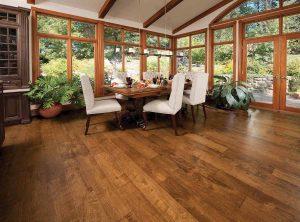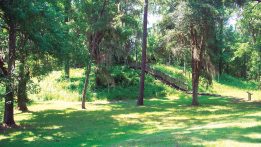 Choosing hardwood flooring for your home can be a valuable investment. Multiple surveys estimate that hardwood flooring can add as much as $7,000-$10,000 to a home’s resale value. A study conducted by the National Wood Flooring Association (NWFA) revealed that ninety-nine percent of U.S. real estate agents asserted that homes with hardwood flooring are easier to sell, and ninety percent said that homes with hardwood flooring sell for more money – up to ten percent more, in fact. In order to get the most out of your valuable investment, here are the hardwood flooring options you need to know about before you buy:
Choosing hardwood flooring for your home can be a valuable investment. Multiple surveys estimate that hardwood flooring can add as much as $7,000-$10,000 to a home’s resale value. A study conducted by the National Wood Flooring Association (NWFA) revealed that ninety-nine percent of U.S. real estate agents asserted that homes with hardwood flooring are easier to sell, and ninety percent said that homes with hardwood flooring sell for more money – up to ten percent more, in fact. In order to get the most out of your valuable investment, here are the hardwood flooring options you need to know about before you buy:
Solid Wood Floors
Solid hardwood flooring comes in three basic types: strip, plank and parquet.
- Strip flooring accounts for the majority of hardwood installations. It is installed by nailing the wood to the subfloor, and each strip is generally no more than three inches wide.
- Plank floor boards are at least three inches wide and can be screwed or nailed to the subfloor.
- Parquet flooring comes in 6”x6” blocks, but specialty patterns can be made much larger. Parquet floors often create a dramatic geometric look.
One thing to keep in mind is that solid hardwood flooring expands and contracts due to changes in your home’s humidity. Installers can compensate for this by leaving an expansion gap between the floor and the wall.
Engineered Wood
Engineered wood is made of multiple layers of different grades or styles of wood that are stacked and glued together under high heat and pressure. This type of flooring is less likely to be affected by changes in humidity.
Wood Laminates
Wood laminates consist of a plywood base topped with a layer of veneer. The veneer coating on wood laminate floors can be sanded and refinished up to three times in most cases.
After selecting the type of hardwood flooring, the next step is choosing a finish that will enhance the wood’s beauty and protect the floor from every day wear, dirt and moisture. The finish will also give hardwood a rich color and luster to match your home’s look and feel. You have a few hardwood finishing options to choose from including the following:
Surface Finishes
Surface finishes are durable and easy to maintain. They involve applying a stain to achieve color followed by a top coat to add a layer of protection. These are the most popular choices of surface finishes:
- Oil-based urethane is the most commonly used floor finish. It is available in different sheens and is generally applied in multiple coats; it also ambers with age.
- Water-based urethane provides a clear finish, produces fewer odors, has a quicker dry time, and is easier to clean up than other finishes.
- Moisture-cured urethane is a solvent-based solution mostly used in commercial applications. It is more durable and moisture-resistant than other options.
- Conversion varnishes are a professionals-only application product that is often used in commercial spaces.
Penetrating Stains and Finishes
These finishes penetrate the wood to form a protective seal. The stains soak in to provide the color, and a wax coating provides a low-gloss satin sheen. These finishes require special care since certain products (such as water-based products) should not be used on the floors.
Sheen Options
Choice of sheen is a personal preference, but it’s helpful to keep in mind that high-gloss finishes show scuffs and scratches more easily than low-gloss or satin finishes. High-gloss finishes also reflect more light and are typically used in commercial settings, while satin finishes are usually favored for more traditional applications.
Extra Durable Finishes
One of the latest trends in hardwood finishes are products designed to extend the life of the floor and make them extra durable. Some manufacturers state that these finishes are ten times more durable than other finishes and can last for up to twenty-five years. Swedish finishes and acrylic finishes are the most popular types of extra durable products. ![]()
By Erin Turner




